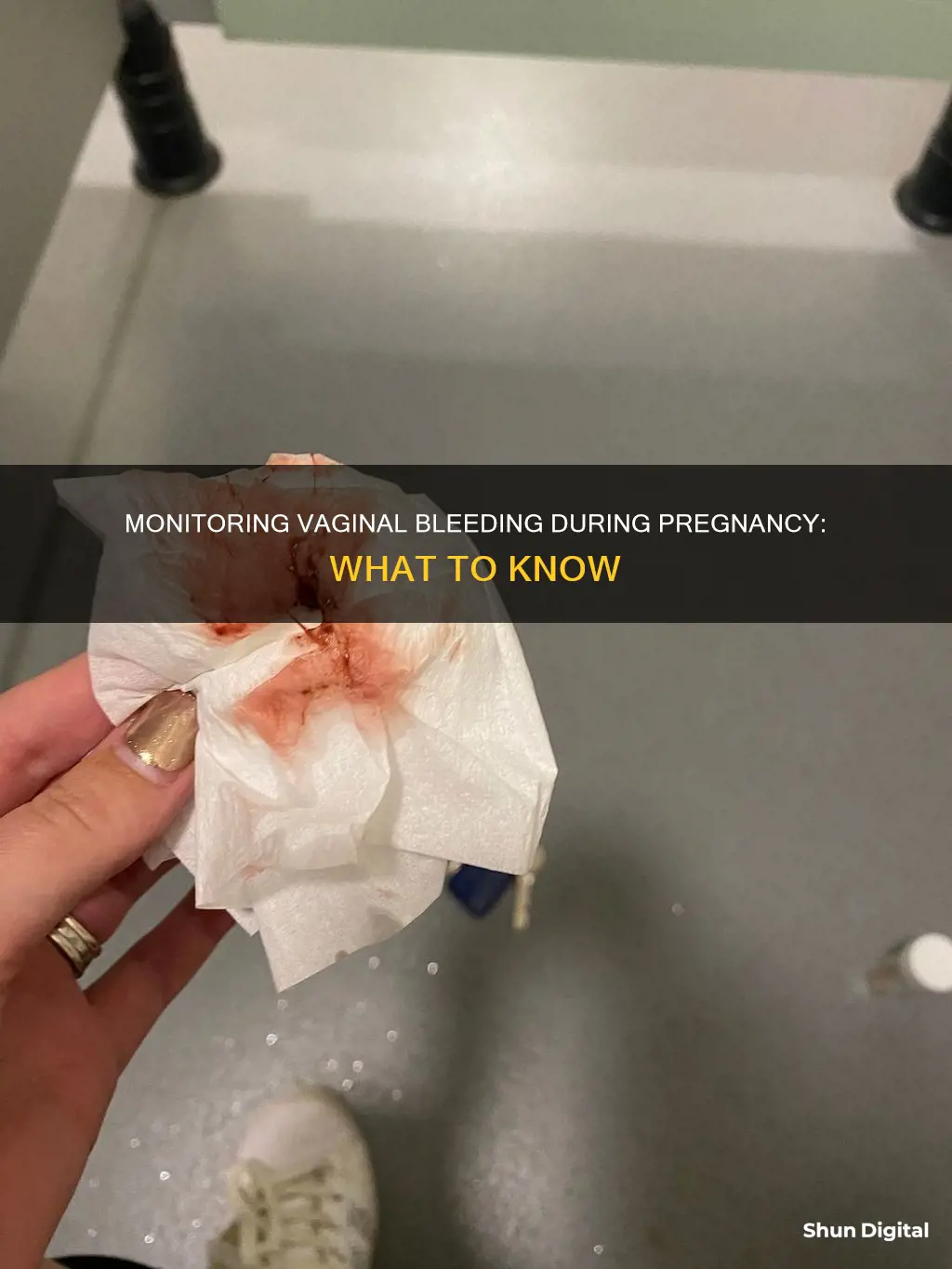
Spotting during pregnancy can be a worrying sign for expectant mothers. However, it is relatively common and not always a cause for concern. It is important to know how to monitor spotting to distinguish between benign and more serious causes. Spotting is characterised by light traces of pink, red, or dark brown blood, while heavier bleeding will require a pad or tampon. This article will discuss the different types of spotting and how to monitor them during pregnancy.
| Characteristics | Values |
|---|---|
| Colour | Pink, red or dark brown |
| Amount | Light |
| Consistency | Smooth, thick or watery |
| Clotting | No clots |
| Scent | No scent |
| Sensation | No itching or burning |
What You'll Learn

What is spotting?
Vaginal bleeding during pregnancy can be alarming, but it's relatively common and doesn't always indicate a problem. However, it's important to monitor spotting and seek medical advice when necessary. So, what is spotting?
Spotting refers to light bleeding during pregnancy. It is characterised by a few drops of pink, red, or dark brown blood on your underwear or toilet paper. The amount of blood is not enough to cover or fill a panty liner. It is typically lighter than your menstrual period. Spotting can occur at any time during pregnancy, from conception to the end of pregnancy. It is most common during the first trimester, with 15-25% of pregnant people experiencing it in the first 12 weeks.
Implantation bleeding is a common cause of spotting early in pregnancy. This occurs when the fertilised egg attaches to the uterine lining, triggering a few days of light bleeding. This usually happens before a woman even knows she is pregnant and may be mistaken for an upcoming period. Other causes of spotting include cervical polyps, which are harmless growths on the cervix that may bleed due to increased estrogen levels and the resulting higher number of blood vessels in the cervical tissue.
While spotting during pregnancy is often harmless, it can sometimes be a sign of a more serious issue, such as an ectopic pregnancy, miscarriage, or molar pregnancy. Therefore, it is essential to contact your healthcare provider and share your symptoms if you experience any vaginal bleeding during pregnancy. They can determine if further evaluation or tests are needed to rule out any potential complications.
Utilizing GPU Potential: Multiple Monitors, One GPU
You may want to see also

When to worry about spotting
While spotting during pregnancy is usually nothing to worry about, there are some instances when you should seek medical advice.
First of all, it is important to understand the difference between spotting and bleeding. Spotting is when you see a light or trace amount of pink, red, or dark brown blood. It will be lighter than your menstrual period and there won't be enough blood to cover a panty liner. Bleeding, on the other hand, is a heavier flow of blood that requires a liner or pad to keep it from soaking your clothes.
If you experience any bleeding in your second or third trimester, you should let your doctor know right away or seek emergency medical care. In the first trimester, spotting is more common, but you should still report it to your doctor or midwife.
Call your obstetrician if you notice heavy bleeding similar to a menstrual period, as this could be a sign of pregnancy complications such as an ectopic pregnancy. Abnormal bleeding in late pregnancy may signal a complication with you or your baby, so contact your doctor as soon as possible.
If you experience any of the following symptoms along with spotting or bleeding, contact your doctor immediately:
- Cramping or contractions
- Pelvic pain or pain in your abdomen
- Dizziness or fainting
- Other signs of preterm labour, such as your water breaking
If your doctor's office is closed, go to the nearest emergency room.
ASUS Monitor Aspect Control: Adjusting Display for Optimal Viewing
You may want to see also

What to do if you experience spotting
While spotting during pregnancy can be alarming, it is relatively common and does not always indicate a problem. However, it is important to monitor any vaginal bleeding during pregnancy and seek medical advice if you have any concerns. Here is a guide on what to do if you experience spotting during pregnancy:
Recognise the Signs of Spotting
Firstly, it is important to understand the difference between spotting and bleeding. Spotting refers to light bleeding, typically characterised by a few drops of pink, red, or dark brown blood in your underwear or on toilet paper when you wipe. On the other hand, bleeding describes a heavier flow of blood that requires the use of a pad or tampon to prevent soiling your underwear.
Contact Your Healthcare Provider
Regardless of whether you are experiencing spotting or bleeding, it is crucial to contact your doctor or midwife. They will assess your symptoms and determine if further evaluation or testing is necessary. Do not hesitate to seek medical advice, even if the bleeding is light or occurs during the first trimester.
Understand Possible Causes
Spotting during pregnancy can have various causes, and it is often challenging to identify the exact reason. Some common causes of spotting in early pregnancy include implantation bleeding, hormonal changes, a sensitive cervix, or cervical changes. In the second and third trimesters, spotting may be attributed to irritation of the cervix after sex or a cervical exam.
Monitor for Any Additional Symptoms
Pay attention to any additional symptoms that accompany spotting. For example, abdominal pain, cramping, fever, or a sudden decrease in pregnancy symptoms may indicate a more serious issue. If you experience heavy bleeding similar to a menstrual period, sharp abdominal pain, dizziness, or other concerning symptoms, seek immediate medical attention.
Follow Medical Advice
Your healthcare provider will guide you on the appropriate course of action based on your individual situation. In some cases, they may recommend bed rest, increased hydration, reduced physical activity, or elevating your feet. If the bleeding is severe, hospitalisation may be necessary. Additionally, your doctor may prescribe medication or suggest specific treatments depending on the underlying cause of the spotting.
Understanding Monitor Resolution and Picture Size
You may want to see also

What causes spotting?
Spotting during pregnancy is usually a light amount of pink, red, or dark brown blood. It is lighter than a period and won't cover a panty liner. While spotting can be alarming, it is relatively common and does not always indicate a problem. However, it is important to monitor and report any spotting to your healthcare provider.
There are several possible causes of spotting during pregnancy, especially in the first trimester. Here are some common reasons:
- Implantation bleeding: This occurs when the fertilized egg implants in the wall of the uterus and can cause light bleeding. It usually happens 6-12 days after conception and can be one of the first symptoms of pregnancy.
- Hormonal changes: The increase in hormones during pregnancy can sometimes lead to spotting.
- Cervical changes: Pregnancy can cause changes to the cervix, making it more sensitive and prone to bleeding, especially after sex or a cervical exam.
- Ectopic pregnancy: This occurs when the fertilized egg implants outside the uterus, such as in the fallopian tube. It is a medical emergency and can cause light to heavy vaginal spotting.
- Miscarriage: Vaginal bleeding, especially when accompanied by cramps and abdominal pain, can be a sign of miscarriage. Most miscarriages occur within the first 13 weeks of pregnancy.
- Infection: Infections such as chlamydia, gonorrhoea, other sexually transmitted infections, or urinary tract infections can cause light bleeding.
- Cervical polyps: These are harmless growths on the cervix that may bleed during pregnancy due to increased estrogen levels and the presence of more blood vessels in the area.
- Other factors: Spotting may also be caused by heavy lifting, excessive exercise, or a gynecological exam.
Passive Monitor Hookup: Easy Steps to Quality Sound
You may want to see also

Spotting in the third trimester
Spotting during pregnancy is when you see a light or trace amount of pink, red, or dark brown blood. It is lighter than your menstrual period and there won't be enough blood to cover a panty liner.
Light bleeding or spotting during late pregnancy may occur after sex or a cervical exam. This is common and not usually a cause for worry. It can also be due to a "bloody show", or a sign that labour is starting.
If you experience heavy vaginal bleeding during late pregnancy, seek emergency medical care. It could be caused by:
- Placenta previa: when the placenta covers all or part of your cervix.
- Placental abruption: when the placenta detaches from the wall of your uterus. This can be dangerous for both mother and baby.
- Preterm labour: going into labour earlier than 37 weeks of pregnancy.
- Labour: going into labour after 37 weeks can also cause bleeding.
- Incompetent cervix: when the cervix opens (dilates) too early.
If you experience a lighter blood flow or light spotting, you should still call your doctor right away. Depending on your other symptoms, you may need an evaluation.
Choosing the Right Wide Monitor: Measure for Best Experience
You may want to see also







